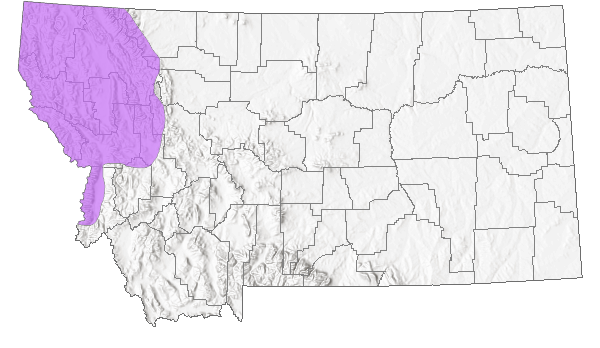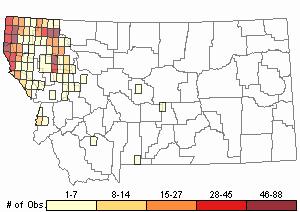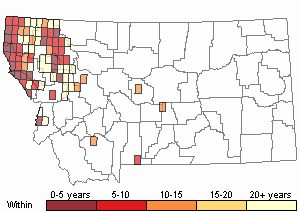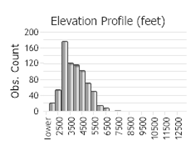View in other NatureServe Network Field Guides
NatureServe
Montana
Utah
Wyoming
Idaho
Wisconsin
British Columbia
South Carolina
Yukon
California
New York
Western White Pine - Pinus monticola
Native Species
Global Rank:
G4G5
State Rank:
S3S4
(see State Rank Reason below)
C-value:
6
Agency Status
USFWS:
USFS:
BLM:
FWP SWAP:
SGCN
External Links
State Rank Reason (see State Rank above)
Pinus monticola populations have been severely impacted by the introduced pathogen, white pine blister rust, and from historic timber harvesting. Pinus monticola is present in northwestern Montana, but at populations much lower than historic levels. It is found on federal, state, private, and tribal lands as well as on other ownerships within its Montana range. The U.S. Forest Service (Region 1 USFS) and the Montana Department of Natural Resources and Conservation (MTDNRC) is actively engaged in management and research to conserve Pinus monticola, as is some private landowners. Region 1 USFS and MTDNRC plant rust-resistant seedlings and implement some forest practices to retain trees. While the trend in the number of Pinus monticola trees is improving, it may still be at levels insufficient to maintain long-term genetic viability across its range. Research on the long-term survival of rust resistant seedlings planted by the MTDNRC in 2012 will contribute to tracking its trend and assessing persistence in Montana. Information on the health and reproductive status of Pinus monticola from private lands is needed.
- Details on Status Ranking and Review
Population Size
ScoreF - 10,000 - 100,000 individuals
Range Extent
ScoreF - 20,000-200,000 sq km (~8,000-80,000 sq mi)
Area of Occupancy
ScoreE - 26-125 4-km2 grid cells
Number of Populations
ScoreD - 81 - 300
Number of Occurrences or Percent Area with Good Viability / Ecological Integrity
ScoreD - Some (13-40) occurrences with excellent or good viability or ecological integrity
Environmental Specificity
ScoreC - Moderate. Generalist or community with some key requirements scarce
Long-term Trend
ScoreCG - Decline of <80% to Relatively Stable
Trends
ScoreG - Relatively Stable (<=10% change)
Threats
ScoreC - Medium
CommentThreat categories include: Fire & fire suppression, Wood & pulp plantations.
Intrinsic Vulnerability
ScoreB - Moderately vulnerable
General Description
PLANTS: Large trees to 60 meters tall with a trunk that can grow to a diameter of 76 centimeters. The crown is cone-shaped (conical) to rounded. Sources: Kral in Flora of North America (FNA) 1993; Lesica et al. 2012.
BARK: Initially bark is thin, smooth, and grey, developing into markedly scaly plates. The scaly plates are square to rectangular, greyish where exposed and rusty brown underneath. Sources: Douglas et al. 1988; Kral in FNA 1993; Lesica et al. 2012.
BRANCHES / BUDS: Branches slope upwards or spread and are almost verticillate on the main trunk. Twigs are slender, somewhat glandular, minutely pubescent, light reddish-brown, turning grey or brownish-purple. Buds are acute at the tip, ovoid to cylindric in shape, reddish cinnamon-brown in color, and a little sticky from resin; 4-5 mm in length. Sources: Cronquist et al. 1986; Douglas et al. 1988; Kral in FNA 1993; Lesica et al. 2012.
LEAVES: Needles are light or whitish (glaucous) blue-green, 4–10 cm long, and grouped in fascicles of 5. Each needle is straight or lightly twisted, flexible, and slender. Stomatal lines are visible only on the adaxial surface. Leaf margins frequently have tiny teeth. Leaf sheaths are deciduous. Sources: Cronquist et al. 1986; Kral in FNA 1993; Lesica et al. 2012.
The genus Pinus comes from the Latin word for 'pine' (Kral in FNA 1993).
Species Range
Montana Range
Range Descriptions

 Native
Native
Range Comments
Southwest British Columbia east to Alberta and south to Montana, Idaho, Washington, Oregon, California, and Nevada (Douglas et al. 1998).
Observations in Montana Natural Heritage Program Database
Number of Observations: 1169
(Click on the following maps and charts to see full sized version)
Map Help and Descriptions
Relative Density

Recency



 (Observations spanning multiple months or years are excluded from time charts)
(Observations spanning multiple months or years are excluded from time charts)
Habitat
Western White Pine is found in moist forests from the valley to montane vegetative zones of western Montana (Lesica et al. 2012)
National Vegetation Classification System Groups Associated with this Species
Forest and Woodland
Montane - Subalpine Forest and Woodland
Ecology
BIOLOGY
Needles remain on twigs for 2 to 4 years (Cronquist et al. 1986).
ECOLOGY
Western White Pine is sensitive to fire, susceptible to blister rust, and cannot thrive in shade (Lesica et al. 2012).
Reproductive Characteristics
Western White Pine is a long-lived (perennial) tree.
CONES
Pollen or male cones grow in the spring (usually), are short-lived, and cluster around the current year's growth. They are yellow, 10-15 mm in length, and disintegrate as pollen is dispersed to the wind. Sources: Kral in FNA 1993; Lesica et al. 2012.
Seed or female cones are woody, persistent, mature in about two years, and drop shortly after seed dispersal. Cones are narrowly elliptic, 15-25 cm in length, clustered, sticky with resin, and light brown to yellowish. Cones hang pendulously on somewhat long stalks in the upper branches. Sources: Cronquist et al. 1986; Kral in FNA 1993; Lesica et al. 2012.
SEEDS
The seed body is reddish-brown, 5-7 mm; wing 2-2.5 cm (Kral in FNA 1993).
Management
Western White Pine is the most important western source for matchwood because it lacks sugary exudates (Kral in FNA 1993).
Stewardship Responsibility
References
- Literature Cited AboveLegend:
 View Online Publication
View Online Publication Cronquist, A., A.H. Holmgren, N.H. Holmgren, and J.L. Reveal. 1986. Intermountain Flora: Vascular Plants of the Intermountain West, U.S.A. Volume 1. Geological and Botanical History of the Region, Its Plant Geography and a Glossary. The Vascular Cryptogams and the Gymnosperms. Bronx, NY: New York Botanical Garden. iii + 270 pp.
Cronquist, A., A.H. Holmgren, N.H. Holmgren, and J.L. Reveal. 1986. Intermountain Flora: Vascular Plants of the Intermountain West, U.S.A. Volume 1. Geological and Botanical History of the Region, Its Plant Geography and a Glossary. The Vascular Cryptogams and the Gymnosperms. Bronx, NY: New York Botanical Garden. iii + 270 pp. Douglas, G.W., G.B. Straley, D. Meidinger, and J. Pojar, editors. 1998. The Illustrated Flora of British Columbia. Volume 1. Gynmosperms and Dicotyledons (Aceraceae through Asteraceae). British Columbia Ministry of Environment, Lands and Parks and British Columbia Ministry of Forests, Victoria.
Douglas, G.W., G.B. Straley, D. Meidinger, and J. Pojar, editors. 1998. The Illustrated Flora of British Columbia. Volume 1. Gynmosperms and Dicotyledons (Aceraceae through Asteraceae). British Columbia Ministry of Environment, Lands and Parks and British Columbia Ministry of Forests, Victoria. Flora of North America Editorial Committee, eds. 1993. Flora of North America North of Mexico. Volume 2. Pteridophytes and Gymnosperms. Oxford University Press, Inc., NY. xvi + 475 pp.
Flora of North America Editorial Committee, eds. 1993. Flora of North America North of Mexico. Volume 2. Pteridophytes and Gymnosperms. Oxford University Press, Inc., NY. xvi + 475 pp. Lesica, P., M.T. Lavin, and P.F. Stickney. 2012. Manual of Montana Vascular Plants. Fort Worth, TX: BRIT Press. viii + 771 p.
Lesica, P., M.T. Lavin, and P.F. Stickney. 2012. Manual of Montana Vascular Plants. Fort Worth, TX: BRIT Press. viii + 771 p.
- Additional ReferencesLegend:
 View Online Publication
View Online Publication
Do you know of a citation we're missing? Aldrich, D. F. 1978. Overwintering, springtime development and migration of some Aphidea, including Myzus persicae of Northwestern Montana. M.Sc. Thesis. Bozeman, Montana: Montana State University. 112 p.
Aldrich, D. F. 1978. Overwintering, springtime development and migration of some Aphidea, including Myzus persicae of Northwestern Montana. M.Sc. Thesis. Bozeman, Montana: Montana State University. 112 p. Cripps, C.L., J.E. Lindgren, and E.G. Barge. 2017. Amanita alpinicola sp. nov., associated with Pinus albicaulis, a western 5-needle pine. Mycotaxon 132: 665-676. https://doi.org/10.5248/132.665
Cripps, C.L., J.E. Lindgren, and E.G. Barge. 2017. Amanita alpinicola sp. nov., associated with Pinus albicaulis, a western 5-needle pine. Mycotaxon 132: 665-676. https://doi.org/10.5248/132.665 Lesica, P., M.T. Lavin, and P.F. Stickney. 2022. Manual of Montana Vascular Plants, Second Edition. Fort Worth, TX: BRIT Press. viii + 779 p.
Lesica, P., M.T. Lavin, and P.F. Stickney. 2022. Manual of Montana Vascular Plants, Second Edition. Fort Worth, TX: BRIT Press. viii + 779 p. Little, E.L., Jr. 1979. Checklist of United States trees (native and naturalized). Agriculture Handbook No. 541. U.S. Forest Service, Washington, D.C. 375 pp.
Little, E.L., Jr. 1979. Checklist of United States trees (native and naturalized). Agriculture Handbook No. 541. U.S. Forest Service, Washington, D.C. 375 pp. Spoelma, Tim. 2015. Western White Pine on State Trust Lands. Prepared for Andrea Pipp, Program Botanist, Montana Natural Heritage Program, Helen, Montana. Prepared by Montana Department of Natural Resources and Conservation, Missoula, Montana.
Spoelma, Tim. 2015. Western White Pine on State Trust Lands. Prepared for Andrea Pipp, Program Botanist, Montana Natural Heritage Program, Helen, Montana. Prepared by Montana Department of Natural Resources and Conservation, Missoula, Montana.
- Web Search Engines for Articles on "Western White Pine"





